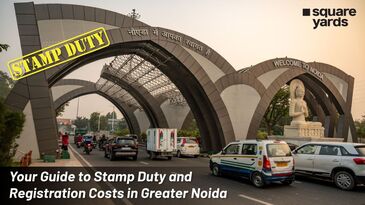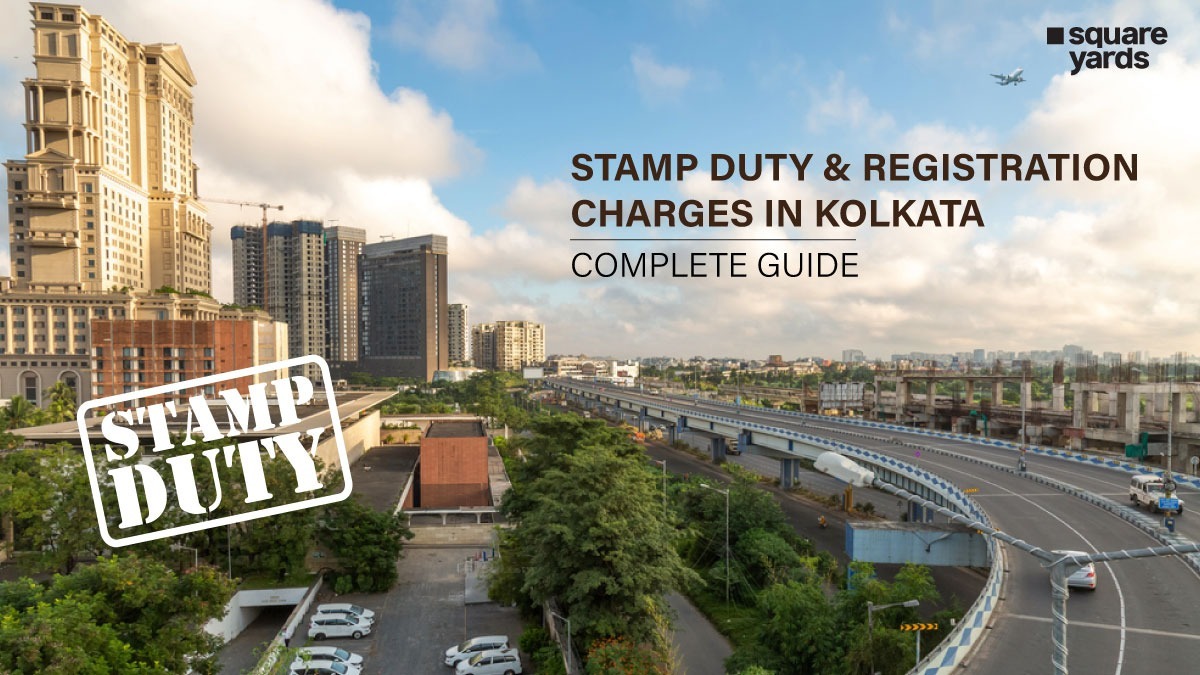A sale deed is a legal paper that documents the sale and transfer of ownership of immovable property between the property and the buyer. Section 54 of the Transfer of Property Act of 1882 defines a sale as “a transfer of ownership in return for a sum paid or promised or partly paid, and part promised.” The Registration Act is the basis of the sale deed in India. The agreement paper outlines all the terms and conditions that apply to both parties. Only when both the parties sign the selling deed does it become legally binding.
Sale Deed Registration Online
In this digital age, making the sale deed online is a very easy and quick task. There is no need for high costs attached to the online process of making sale deed registration. Follow the simple steps given below to complete sale deed registration online:
- Start your web browser and open the e-registry.in website
- Click the left-side tab on the website that reads Sale deed to see a drop-down that features some sub-options such as:
- Agriculture Land
- Agriculture Land in Commercial Open Land
- Agriculture Land in Commercial Shop
- Agriculture Land in Residential Open Land
- Conversion Land Flat/Villa
- Commercial Patta in Open Land/Shop
- Residential Patta in Open Land/House
- Shopping Mall and Plaza in Shop/Office
Choose one from the options that suit your requirement and click on that.
- Fill out the sale deed registration form now. Complete the form, fill in the details with your name, email address, and phone number, then click the Submit button. Your document will be saved in the database with this information, and you will be able to download it at any time and from any location.
- The registered sale deed form is now available. Complete all fields and click on the Save button.
- When you press the save button, a preview of your document appears. Check out all the filled-in details. If all of the information is accurate, select the payment option and pay the little fee using Paytm or other payment methods.
- You will find the paper in your profile option once your payment is complete. Here you will find all of the documents that you have created. Select the download option to save and print your paper.
All the above steps in the online process make the sale deed registration effortless and fast.
Registration Of Sale Deed
An essential document for both the buyer/transferee and the seller/transferor is the registration of a sale deed. This is controlled by the ‘Registration Act, 1908.’ The sale deed registration in the Sub-Registrar’s office is mandatory. An unregistered sale deed has no legal value and does not transfer ownership to the buyer.
Leasehold homes can now be sold using documents such as an Agreement to Sell, a GPA, a Builder Buyer Agreement, and an Apartment Deed.
A registered sale document can also be used to transfer ownership of agricultural land, leasehold buildings, and other real estate. It is also possible to record a tripartite sale deed with a confirming party.
Before having the sale deed completed and registered, the buyer must:
- Complete a Title Search (evaluation of ownership and claims on a piece of real property before a transaction) and acquire an Encumbrance Certificate (certificate of assurance that the concerned property) to review and validate the seller’s title papers. This is to ensure that no encumbrances already exist on the property.
- Check If there is a charge or mortgage on the property. Also, check if there are any pending taxes, water, or electric charges on the property. In this case, the seller should clear it before signing the selling paperwork.
Sale Deed Registration in India
The real estate agreements in India fall under the following enactments:
- Transfer of Property Act 1882 (TPA);
- Indian Contract Act 1872 (Contract Act);
- Real Estate (Regulation and Development) Act 2016 (RERA);
- Registration Act 1908 (Registration Act);
- Indian Stamp Act 1899 (Stamp Act); and
- Indian Easements Act 1882 (Easements Act).
The following points should be kept in mind:
- The Registration act explains how to register, what documents should be registered, and how to accomplish it.
- According to section 17 of the Indian Registration Act, 1908, when an agreement of transfer or interest in immovable property of value exceeds Rs 100, it should be registered.
- If an individual purchases a place under a sale or lease agreement without making an accurate sale deed, they will have no right to have ownership of the property.
- Under the Registration Act, the property title will remain with the Developer until a sale deed is executed and registered, even if a property is bought under a sales agreement and is in possession.
- A registered sale deed is mandatory for the property’s title to be transferred from the seller to the buyer.
- A registered sale deed without possession by the buyer makes no difference if the deed is executed and appropriately registered.
Lease
- The rent note is a lease arrangement covered under the Registration Act’s broader definition of a lease. A lease deed follows this.
- The rent note or lease agreement might be in the form of a counter-part signed by both parties. If there isn’t a recent death, the agreement can be made orally or through an unregistered document.
- A lease agreement signed only by the lessee is not a lease, but it would be if it were registered under the Registration Act, and the matter of the registration would be determined under that Act.
- The lease deed is a formal agreement between a landlord (lessor) and a tenant (lessee) that states the landlord will be paid regularly to allow the tenant to use and maintain the property.
- The terms and circumstances that govern the relationship between a landlord and a tenant throughout the lease are also described in this document.
- The registered lease deed must be submitted with the Sub-Registrar or Registrar of the district in which it is located once it has been written.
- A lease document is only recorded when the necessary stamp duty has been paid, which varies by state.
Sale Agreement Registration Procedure
- The sale agreement document is the foundation on which the sale deed is created. It is one of the first steps in the transferring process of immovable properties.
- At the time of registration, the owner must be present along with two witnesses and the essential documents.
- The registration is to be done at the local sub-repertory office, the documents are scanned in the sub-registry office and returned to the owner.
- The sale agreement registration cost is paid as stamp duty, and the information must be recorded on non-judicial papers.
- The registry office provides a certified copy of the registered rental status under the buyer’s name.
How To Check for Registered Sale Deed
The sale deed document is legal evidence that the sale is complete. The Sale Deed Registration Process is as follows:
Preparation
- The seller must pay the total consideration amount following the sale agreement before the registration.
- There should be no prior due amounts in tax, loans, mortgages, or other charges on the property.
- In such cases, the registrar can choose to decline from registering the sale deed.
Stamp Duty
- The circular rate or the actual value, whichever is higher, is subject to stamp duty.
- Stamp duty might range from 3 to 10%, which varies from state to state.
- Apart from the stamp duty, the individual needs to pay a 1% registration charge.
- The payment can be done online, available in many states such as Odisha, Tripura, Ladakh, Chandigarh, Delhi, among others.
- After registering online, stamp duty is ideally paid through net banking/debit card/NEFT/RTGS/FT.
- One must carry a printout of the Online Reference Acknowledgement No. after submitting stamp duty.
- They can visit the nearest Stock Holding Branch to obtain a final printout of the e-Stamp Certificate. Each stamp paper contains a unique identifying number that may be used to identify it in the future.
- Otherwise, an individual can buy the required amount of stamp paper from an authorized stamp vendor in their area. They can print the sale deed on paper and submit it to the registrar’s office.
Drafting and Printing the Sale deed
- Create the sale deed that should include the seller, buyer, and payment details. It should also have the terms of the sale as well.
- If the individual has an e-stamp, they can print the deed on plain paper and then attach the e-stamp.
Registration
- After making an appointment at the closest sub-registrar office, they would provide a token with the date and time for appearance.
- States that provide an e-stamping facility also provide their citizens to fix an appointment online.
- The buyer and seller and two witnesses each must be present at the time of registration on the appointed day.
- Buyer and seller sign each page of the deed, and the witnesses have to sign the last page of the document. The buyer and seller have to provide fingerprints as well.
After the registration, a token slip is provided for future references and for collecting the sale deed. It would contain the sale deed registration number and would be under the buyer’s name. The original sale deed can be collected 15-20 days after the registration.
In case the sale deed is stolen or lost, the buyer needs to:
- Immediately file police complain
- Apply for a certified copy of the sale deed
- Place an advertisement in the local and national newspaper with all the details of the lost document and contact details.
- Make an Affidavit and which then needs to get notarized
- Collect the duplicate registered sale deed from SRO
Checklist for Registration of Sale Deed
A buyer/leaser must check a few things before drafting a sale deed or registering a tenancy agreement or sale agreement, and a buyer/leaser must check a few things.
- Ownership of the property– They must look through the certified Copy of Original Old Sale Deed, the Fard of Jamabandi, or a mutation deed.
- Identification of both parties is essential, including the name and address of the buyer and seller.
- Registration of documents through a power of attorney is mandatory
- A No Objection Certificate (NOC) from the DTP (Directorate of Town and Country planning) may be required. It must contain the building plan and map of the area. The local municipal authorities must approve the building plan.
- The building plan includes the details of the property. In case of a lease, the plan must outline the layout and the utilities provided, if any. Additionally, digital photographs of buildings/plots are important inclusions too.
- The map plan must contain the description of the immovable property
- Witnesses must be found and present during the sale agreement and deed procedure
Essential clauses to be included in a sale deed or lease deed registration:
- Description of the parties
- Description of the property
- Date and Place of execution of the deed by the seller and buyer
- The agreed-upon selling consideration/cost between the seller and the buyer, which the buyer must pay to the seller upon execution of the sale document.
- The time the title of the property will be passed on from the seller to the buyer.
- Proof of all prior charges and taxes cleared by the seller
- An encumbrance certificate to verify the encumbrance status
- Signature on each page of the deed by the buyer and seller. Fingerprints and thumb impressions of both parties should be provided.
- The signature on the last page of the deed by the witnesses who are present during the registration. At least two witnesses must be present, ideally one representing each party.
- All the original documents must be handed over from the seller to the buyer after the registration.
The following documents are required during sale deed registration in India:
- A duplicate copy of the Sale Deed is required for registration.
- Two passport-size photos of the buyer and seller, as well as ID evidence from all parties, such as an Aadhaar card or a voter’s ID card.
- In the case of a firm, genuine certified copies of the Certificate of Incorporation are required.
- A copy of the property registration card indicating that the government does not own the property.
- To show the year the property was built, a copy of the municipal tax bill and the seller’s PAN cards.
- Receipt of the registration fees and stamp paper (or e-stamp).
Documents Required for Sale Deed Registration in Delhi
When buying a property in Delhi, buyers must the registration amount and stamp duty during the registration process. However, stamp duty for women buyers in Delhi is kept low to encourage property ownership. This is per the Registration Act of 1908.
- The stamp duty rate is 6% for males, 4% for females, and 5% for joint ownerships.
- The stamp tax on property sales within the New Delhi Municipal Corporation (NDMC) jurisdiction is 5.5%.
- The relevant stamp duty for female buyers in this region is 3.5%of the property cost.
- The stamp tax on property sold inside the Delhi Cantonment Board jurisdiction is 3%.
- Everyone has to pay an additional 1% charge for registration
- Buyers can pay for stamp duty online, as is the course for e-stamping. They can pay through net banking, cards, etc.
- Regarding lease deed registration fees, stamp duty is 2% of the average rent when the lease agreement is up to 5 years. When the agreement is up to 10 years, it is 3%
- A lease deed registration compulsory if the term is more than a year.
Section 17 Registration Act talks about all the necessary documents that need to be provided during the registration of the sale deed.
The following documents are required during property registration in Delhi:
- Sale Deed
- Proofs of the buyer’s, seller’s, and witnesses’ identities.
- Address the buyer’s, seller’s, and witnesses’ proofs.
- On two copies of the papers, two passport-sized photos of the buyers and sellers.
- e-Stamp paper with the exact stamp duty amount.
- e-Registration fee receipt, together with an undertaking or affidavit.
- Copy of PAN card or Form 60 that has been self-attested.
- In the event of a plot of land, a no-objection certificate (NOC) is required.
- A single set of copies accompanies all original papers.
Sale Deed Registration Fee
- All buyers must pay 1% of the total sale consideration plus Rs 100 for copying charges as the registration charge.
- If the sale consideration exceeds 50 lakhs, the buyer will need to remove 1% TDS from the sale consideration.
- Combining the stamp duty and registration charge, in Delhi, male property owners have to pay 7% charges, women property owners have to pay a total of 5%, and joint owners have to pay 6% of the total sale consideration.
In case of lease registration:
- If the monthly rent is up to 50 lakhs, the buyer’s total expenditure in registration for a 3-year term is between 17,000-19,000, for a 6-year term is between 25,000-27,000, and for a 9-year term is between 27,000-30,000.
- If the monthly rent is up to 2 lakhs, the buyer’s total expenditure in registration for a 3-year term is between 55,000-58,000, for a 6-year term is between 74,000-77,000, and for a 9-year term is between 90,000-95,000.
- If the monthly rent is up to 5 lakhs, the buyer’s total expenditure in registration for a 3-year term is between 1,27,000-1,30,000, for a 6-year term is between 2,00,000-2,07,000, and for a 9-year term is between 2,10,000-2,22,000.
You Might Also Like
Frequently Asked Questions (FAQ’s)
What is the procedure to get a POA registered in India?
Under section 85 of the Indian Evidence Act, a Power of Authority (POA) must be authenticated by either a court, notary, judge, Magistrate, Indian Counsel, or central government representative. The document to be sent for POA registration must contain the identity of the person and their address, clear outlines of the power that need to be transferred to the person, registration document. The document has to be drafted by the executor (person who wants to appoint a POA).
What is the difference between a gift deed and a sale deed?
A sale deed can only be transferred from a seller to a buyer after a sale for the property is complete. The property title is transferred only after the agreed-upon amount is sent to the seller by the buyer. The sale deed, along with all the original documents of the property, is transferred to the buyer. A gift deed enables the transfer of property ownership between two parties without the exchange of money.
Section 17 of the Registration Act, 1908, and section 123 of the Transfer of Property Act obliges it to register a gift deed with the sub-registrar.
Why is a sale deed needed?
A sale deed is an essential document during a property sale. It is a legally binding document proof of a transfer of ownership between a seller and a buyer.
How much is the stamp duty in India?
It is a tax levied on property transactions by the Indian government under the Indian Stamp Act, 1899. The stamp duty rate ranges from 2%-7% of the sale agreement in different states.
What is the home sale and registration process in India?
After a buyer and seller agree upon the price of a property, they must make a sale agreement and register it. This document is instrumental in the execution of the sale deed document, which is then registered.
During registration, both parties must provide all the relevant information to be filled in the form and sign each stamp paper on which the deed is created. They must provide their fingerprints and thumb impressions too. At least two witnesses (one from each side) must be present to sign the sale deed.
Once the sale deed has been registered, and the necessary changes are all cleared, the property’s title is transferred to the buyer. The seller provided all the original documents of the property to the buyer.
Do lease deeds have to be registered?
If the term of stay exceeds 1 year, it is mandatory to get a lease or rent deed registered in the sub-registrar office.
What is the registration of the lease deed?
The lease deed is a formal agreement between a landlord (lessor) and a tenant (lessee) that states the landlord will be paid regularly to allow the tenant to use and maintain the property. After registration, the deed becomes legal evidence of the agreement between a lessor and a lessee.
What happens if a lease deed is not registered?
If a lease deed is unregistered, it is invalid and inadmissible proof in the eyes of the law.
Can a lease be registered?
A lease has to be registered for any agreement between the tenant and the landlord legally binding similar to a sale deed.






























